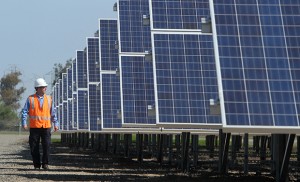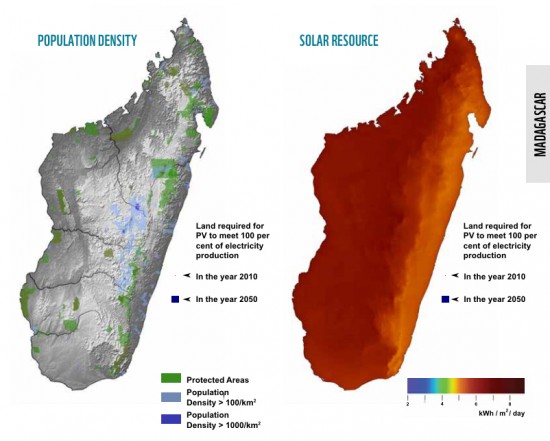Solar Could Meet All The World's Electricity Needs Using Under 1% Of World's Land
 Highlighting the fact that a global switch to renewable energy is not just necessary, but doable, a new report released by the WWF concludes that the solar arrays necessary to meet all the world’s projected energy needs in 2050 would cover under one percent of global land area. Obviously this is a theoretical exercise, and 100 percent of the planet’s electricity needs are not actually going to be filled through solar. But several credible scenarios suggest that solar could provide about 30 percent of global total electricity in 2050, up from the 0.1 percent it provides now.
Highlighting the fact that a global switch to renewable energy is not just necessary, but doable, a new report released by the WWF concludes that the solar arrays necessary to meet all the world’s projected energy needs in 2050 would cover under one percent of global land area. Obviously this is a theoretical exercise, and 100 percent of the planet’s electricity needs are not actually going to be filled through solar. But several credible scenarios suggest that solar could provide about 30 percent of global total electricity in 2050, up from the 0.1 percent it provides now. By going through the numbers, the Solar PV Atlas demonstrates both the practical feasibility of renewable energy, and the possibility of harmonizing solar energy with conservation goals:
The atlas considers electricity demands in seven diverse regions and calculates the area (land or roof) that would be needed for PV to meet these demands. In each of these cases, less than one per cent of the region’s total land cover would be required to host solar PV panels in order to meet one hundred per cent of the region’s projected electricity needs in 2050, taking into account solar resources and predicted electricity consumption and demographic changes.
With its selection of diverse areas, the atlas illustrates that PV technology, when well-planned, does not conflict with conservation goals. On a macro level, no country or region must choose between solar PV and space for humans and nature. Quite the opposite. As climate change threatens humans and the environment, it is more important than ever to work for the efficient and wide-scale adoption of well sited, responsibly and effectively operated renewable energy generation facilities. Environmental protection and renewable energy can and must develop in parallel.

In the map of Madagascar above, the small read and blue squares represent the land area needed for solar to meet 100 percent of the country’s projected electricity needs in 2010 and 2050, respectively. They’re drawn to scale relative to the map, in order to provide a straightforward visual comparison.
The Atlas also goes through Indonesia, Mexico, Morocco, South Africa, Turkey, and the Indian state of Madhya Pradesh as examples. “The regions represent diverse geographies, demographics, natural environments, economies and political structures,” the Atlas points out. “They receive different average levels of sunshine, and all show vast potential for widespread development of solar PV.”
The Atlas builds on the earlier Energy Report from the WWF, which anticipates a total drop in global energy production by 2050. That’s due to increased efficiency outpacing population growth, thus allowing the same energy needs to be met with less energy. At the same time, it anticipates renewable-based electricity ramping up massively, finally displacing all other forms of electricity by 2050.
You can return to the main Market News page, or press the Back button on your browser.

